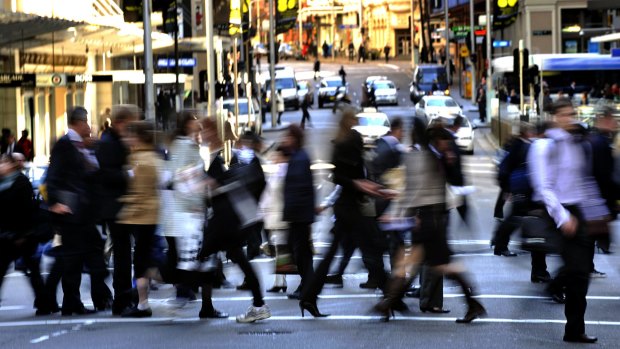This was published 6 years ago
Census 2016 reveals a smarter, more professional Sydney
By Matt Wade
One in four of the nation's professionals – including lawyers, doctors, accountants and engineers – now works in Sydney after their numbers in the city swelled by a third during the past decade.
The latest figures from the 2016 census, which focus on employment, education and internal migration, show a bigger share of Sydneysiders work full-time and hold a bachelors level qualification or higher than the national average. But the city has a smaller share of tradesman and labourers than the rest of the nation.
The new census figures, released on Monday, revealed a nationwide surge in workers who provide personal services. Since the last census in 2011 the number of domestic cleaners has jumped 130 per cent while the tally of fitness instructors was up by 27 per cent and beauty therapists by 25 per cent.
But Sydney's workforce is dominated by professionals and managers with four in 10 of the city's workers in those two broad employment categories.

Sydney's professional ranks have grown by a third in the past decade, the 2016 census shows.Credit: Rob Homer
The number of Sydney-based professionals has climbed by 145,000 during the past decade to almost 600,000. They now make up 26.3 per cent of the city's workforce, up from 23.8 in 2006. Nationally, the census counted 2.3 million professionals, or 22.2 per cent of workers.
Macquarie University demographer Associate Professor Nick Parr said the growth in professionals has been driven by the expansion of higher education student numbers and the high rate of skilled migration.
The census data, released on Monday, showed women now make up 55.4 per cent of professionals nationally, up from 53.9 per cent in 2011.
"The predominance of females in these occupations reflects the greater numbers of females among university graduates over recent decades," Dr Parr said.
"The retirement of more male-dominated cohorts, Baby Boomer cohorts out of the professional occupations is also contributing to the rising share of females in these occupations."
The retirement of more male-dominated Baby Boomer generation managers has also helped lift the share of female managers from 35.4 per cent in 2011 to 37 per cent in 2016.
The share of Sydneysiders with a bachelors degree level qualification or higher has reached 28.3 per cent, more than six percentage points above the national average.
The healthcare and social assistance sector was the biggest employer in both NSW and Australia. It now provides one in eight of the state's jobs. Nationally, almost 80 per cent of the 1.35 million people employed in the healthcare and social assistance sector are women.
Occupations traditionally dominated by women including health care and education grew strongly between 2011 and 2016 but there were big declines in some traditionally male-dominated industries including manufacturing (-24.3 per cent) and wholesale trade (-23.8 per cent).
In Sydney, the share of technicians and trades workers has edged lower over the past decade to 11.7 per cent and is well below the national average of 13.5 per cent. Sydney also has a smaller proportion of labourers (7.5 per cent) than the national average of 9.5 per cent.
When it comes to commuting, Sydneysiders are much more likely to catch public transport to work than those in other capital cities. Even so, the majority of Sydney employees still brave the traffic and drive to their workplace.
Nationally, the number of child carers rose by almost 30 per cent between 2011 and 2016 and the number of early childhood teachers rose 48 per cent in that period.
Dr Parr said a "substantial increase in the number of births between 2006 and 2011" had contributed to those increases along with rising rates of participation in the labour force by mothers.
The ageing of the population is also having an effect on the way Australians work with a 22.2 per cent increase in the number of aged and disabled carers between 2011 and 2016).
The most common individual occupational category for men and women remained "sales assistant".
The latest figures followed the initial release of 2016 census data in June.